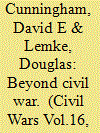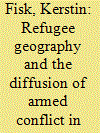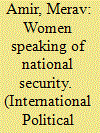|
|
|
Sort Order |
|
|
|
Items / Page
|
|
|
|
|
|
|
| Srl | Item |
| 1 |
ID:
136093


|
|
|
|
|
| Summary/Abstract |
A large quantitative cross-national literature examines why countries are more or less likely to experience civil war. Many of the theories motivating hypotheses about civil war are really arguments about when violence will happen without necessarily explaining why this violence is organized or targets the state. In this article, we examine how variables identified as causing civil war affect other forms of internal violence such as communal conflict, one-sided violence, riots, purges, and coups d'état. We find that factors such as ethnic fractionalization, population, terrain, economic development, and regime type similarly affect different measures of violence. We suggest two avenues for further research – expanding beyond civil war to study determinants of violence within countries more broadly and focusing more directly both theoretically and empirically on the specific determinants of civil war.
|
|
|
|
|
|
|
|
|
|
|
|
|
|
|
|
| 2 |
ID:
136094


|
|
|
|
|
| Summary/Abstract |
A large literature demonstrates that civil war is recurrent: States that have already experienced such conflict tend to relapse back into war. How might this ‘conflict trap’ be escaped? We answer this question with a focus on gender. Women tend to exist at the margins of society, and postwar society often perpetuates prewar values. Yet this continuity is not inevitable. We argue that the end of a civil war opens a window of opportunity through which women may increasingly participate in society, economics, and politics. Given women's preference for peace and aversion to political violence, we expect this increased participation to reduce the risk of relapse to civil war. Large-N analyses support our argument, and in particular suggest that increases in female literacy and parliamentary representation reduce the risk of relapse.
|
|
|
|
|
|
|
|
|
|
|
|
|
|
|
|
| 3 |
ID:
136091


|
|
|
|
|
| Summary/Abstract |
This article develops a conceptual framework to explain that a rebel group, in war-to-peace transition, is likely to use violence in contested areas in order to reclaim its control over territory and populations. The decision to use violence, however, depends on whether post-accord elections are held prior to the demobilization of rebel combatants. Use of violence would still be a preferred strategy for a rebel group should the participation in elections fail to produce the expected outcome. Violence influences post-conflict elections, and when the use of violence determines an electoral outcome, parties involved in the peace process may find it difficult to reconcile their differences on peace agreement implementation. District-level data from Nepal are used to test the arguments, and the effect of post-accord violence on peace processes is evaluated in a comparative perspective.
|
|
|
|
|
|
|
|
|
|
|
|
|
|
|
|
| 4 |
ID:
136092


|
|
|
|
|
| Summary/Abstract |
Focusing on livestock raiding, a major form of violence in arid and semiarid regions, we evaluate the relationship between rainfall and intensity of violence, disaggregating ethnic groups that have somewhat different subsistence patterns. We do so to try to resolve previously published results and conclusions that appear contradictory – some research finding livestock violence higher in wet times suggestive of more violence in times of plenty; others finding violence higher in dry times suggestive of greater scarcity. Using rainfall from NASA and violence data from ACLED for the years 1998–2009, we looked at the patterns of livestock-related violence for six different ethnic groups that have a home in the area in and around Marsabit district of Kenya. Different ethnic groups appear to have somewhat different patterns and we suggest how some of their cultural differences may explain these patterns. However, for most groups, intense violence is more common in drier times.
|
|
|
|
|
|
|
|
|
|
|
|
|
|
|
|
| 5 |
ID:
136090


|
|
|
|
|
| Summary/Abstract |
Why are refugee populations associated with the spread of conflict? Do refugees upset local dynamics by increasing the mobilization opportunities of rebels? Work on rebel motivation predicts that the strategic impact of a location influences armed actors' decisions to fight there; thus, I identify two strategic aspects of refugee geography which may influence where conflict takes place in the host country – refugee mass and refugee accommodation type. I examine the influence of these factors using a new, disaggregated dataset on refugees in 26 African countries engaged in armed conflict during the period 2000–2010.
|
|
|
|
|
|
|
|
|
|
|
|
|
|
|
|
| 6 |
ID:
136095


|
|
|
|
|
| Summary/Abstract |
The production of reports and the distribution of information have become integral to the operation of many non-governmental organizations. In this regard, the fact that the all-women organization of Checkpoint Watch publishes reports about the Israeli checkpoints in the occupied West Bank seems to comply with current trends. However, the reports—most of which are short repetitive descriptions of the banality and everydayness of the military checkpoints, counting the number of people and cars waiting, commenting on the manner in which the checks are performed and meticulously documenting what mostly amounts to minor incidents of humiliation and distress—do not seem to abide by any convention of reporting. This work analyzes the reporting praxis of the organization and claims that it should be understood as a form of activism in and of itself. Tracking the ways in which the reports address the Israeli public through the concept of parrhesia, the work suggests that this form of reporting enables the women activists to use their gendered marginality to make their way into the highly masculinized and militarized Israeli security discourse.
|
|
|
|
|
|
|
|
|
|
|
|
|
|
|
|
|
|
|
|
|